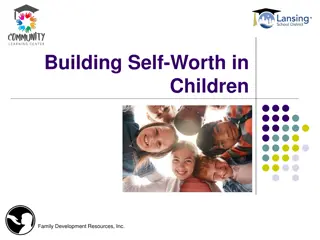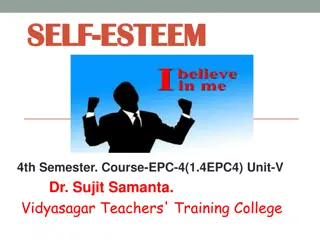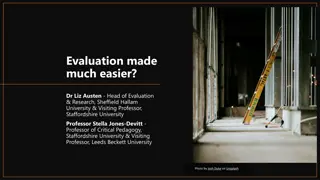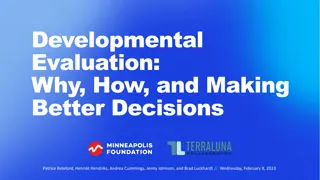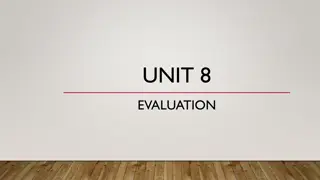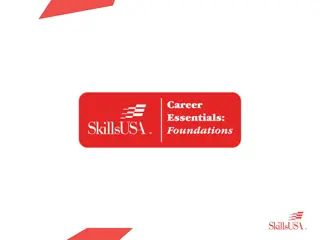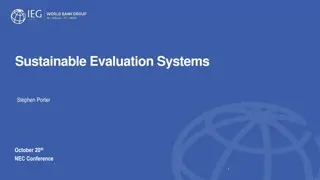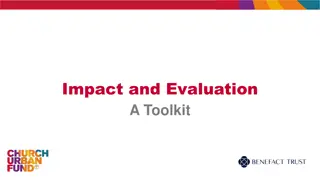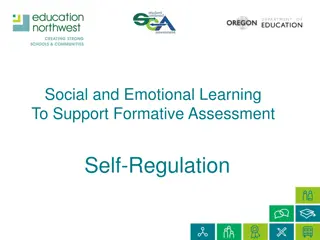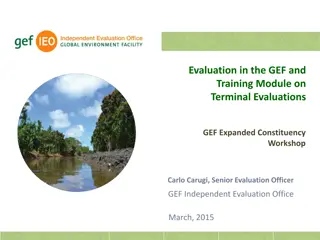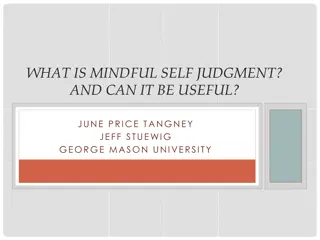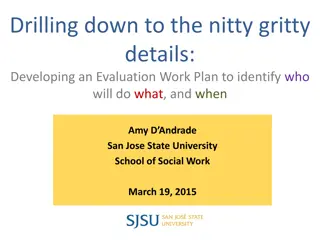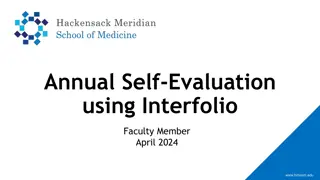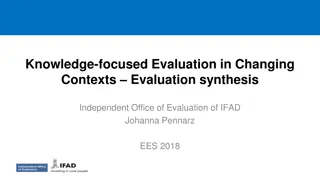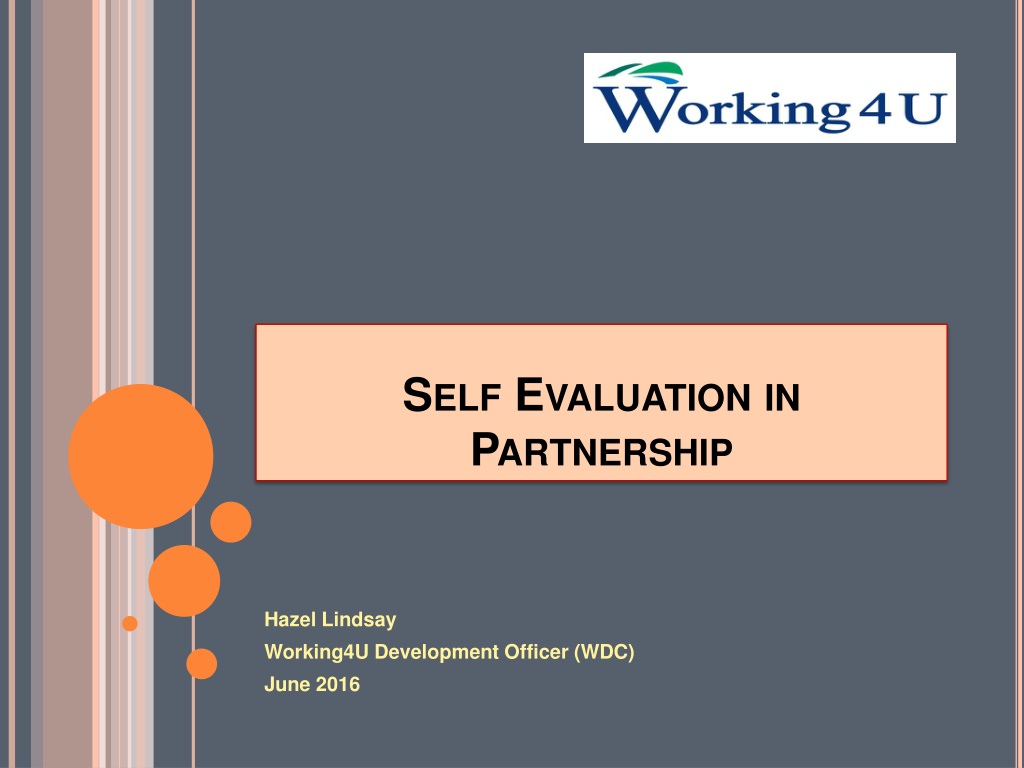
Engage in Effective Self-Evaluation for Continuous Improvement
Enhance your understanding of self-evaluation processes and frameworks to drive improvement in your work. Explore how to select quality improvement areas, involve stakeholders, and plan for future evaluations effectively. Utilize resources to support staff and volunteers at all levels in becoming more confident with self-evaluation practices.
Download Presentation

Please find below an Image/Link to download the presentation.
The content on the website is provided AS IS for your information and personal use only. It may not be sold, licensed, or shared on other websites without obtaining consent from the author. Download presentation by click this link. If you encounter any issues during the download, it is possible that the publisher has removed the file from their server.
E N D
Presentation Transcript
SELF EVALUATION IN PARTNERSHIP Hazel Lindsay Working4U Development Officer (WDC) June 2016
SESSION OUTCOMES Increased knowledge and understanding of: Self-evaluation process and associated Frameworks Why we do it Who should do it When we should do it How we should do it What difference it will make What actions we need to take forward from today .
WHAT ACTIONS WE NEED TO TAKE FORWARD FROM TODAY . Think about what areas of your work needs self-evaluation Select QI s to form self-evaluation around Review and improve your current self-evaluation processes referring to appropriate Quality Framework Plan for a systematic approach to future self-evaluation Consider who you need to involve? What are the best methods/tools to use? Where can you find them? What support might you need to do self-evaluation and who can provide it?
FAMILIAR PROCESS? Self- Review evaluation Monitor/ Gather Data Improvement planning Action
WHY WE DO IT. THE ROLE OF QUALITY ASSURANCE FRAMEWORKS IN CLD PRACTICE Self-evaluation is the process of reflecting on the services we deliver in order to answer critical questions. In doing so, we identify key strengths and areas for further development to drive improvement. These are some of the frameworks which are tools to support the process.
WHY USE THIS RESOURCE? It helps those adopting a CLD approach to their work understand what they are doing well and what they can do better. It will support you to understand and improve the impact you are making. It supports staff and volunteers at all levels to become more confident with self-evaluation. It is free to use. It gives you challenge questions to prompt discussion. You can use part or all of the resource. It can be used alongside other evaluation resources. It shares a common language with other evaluation frameworks developed by Education Scotland.
WHO SHOULD DO IT? Activity: Think about who you would involve in a self-evaluation process. Discuss who you have chosen and why. Is there anyone you would not involve? If so Why?
WHENSHOULDWEDOIT? Activity Think about when you would undertake self-evaluation. Discuss this and feedback to the wider group in visual form using your flipchart paper. Is there any time you would not consider undertaking self- evaluation? If so why?
DISCUSSION What experience do you have of self-evaluation? What were the main challenges? How did you decide the focus of self-evaluation? What would have helped?
HOWSHOULDWEDOIT? Look through the document you will see a number of quality indicators which focus on specific areas for improvement. They will help you identify your strengths and areas for improvement. They will help you understand the difference you are making and what you need to do next. They are designed to support you in thinking about how well you use resources and ideas from elsewhere and plan for coming changes. https://education.gov.scot/improvement/Documents/Frameworks_SelfEvaluation/FRWK4_HowGoodisth eLearningandDevelopmentinourcommunity/frwk4-how-good-is-the-learning-and-development-in-our- community-v2.pdf
HMIE (POTENTIAL) AREASOF FOCUSSED ATTENTION CLD Plans and meeting the CLD Regulations including themes of Prevention and Early-intervention Leadership Shared Planning and Self-evaluation with partners Partners delivering aspects of the curriculum: Raising Attainment & Achievement, Health & Wellbeing, Senior Phase (CfE), Transitions and Progression: Closing the poverty-related attainment gap Learner Voice: Stronger, more resilient communities involved in shaping services: Empowering Communities Equality: Tackling Health Inequalities and Reducing Social Isolation
NEW HMIEINSPECTIONFORMAT From Sept 2016 The inspection model will take place within the context of The Requirements for Community Learning and Development (Scotland) Regulations 2013 and the Strategic Guidance for Community Planning Partnerships: Community Learning and Development (2012). The Scottish Government s National Performance Framework sets out the strategic objectives for all public services, including those delivering CLD. Within this, CLD s specific focus is: improved life chances for people of all ages through learning, personal development and active citizenship; stronger, more resilient, supportive, influential and inclusive communities.
INSPECTION Within this inspection model, we will work with the local authority and CLD partners to focus on: 1. How good is the strategic leadership of community learning and development?; and 2. How good is the learning and development in a defined local community? Education Scotland Community Learning and Development Inspections eBriefing note and templates August 2016 http://www.educationscotland.gov.uk/inspectionandreview/about/cldinsp ections/index.asp
QUALITY INDICATORS - INSPECTION 1.1 Improvements in performance 4.1 Impact on the local community 5.1 Delivering the learning offer with learners 9.2 Leadership and direction also consider the following theme from: 3.1 Impact on staff and volunteers: The extent to which staff and volunteers are supported to reflect on and improve their practice through regular access to relevant, high quality learning and development activities and are developing leadership capacity.
WORKING4U Compliance: So how ready are we, and how do we know?
HOWGOODISTHELEARNINGANDDEVELOPMENT INOURCOMMUNITY? KEY QUESTIONS How do we know? What key outcomes have we achieved? How well do we meet the needs of our stakeholders? How good is our delivery of key processes? How good is our operational management? How good is our strategic leadership? What is our capacity for improvement? What are we going to do now?
Start with any quality indicator Look at them in any order. Don t need to use every quality indicator, but they do relate to each other so looking at more than one or two will give you a broader understanding of your impacts. Some practitioners choose to start by looking briefly at all of the quality indicators. By doing this they identify those that are most appropriate for them to explore in more detail. (Ed. Scotland HGIOLDIC 2016)
HOWWESHOULDDOIT. Plan for it be organised Embed self-evaluation build into processes Use Frameworks for reference from How good is our range. (Education Scotland) Systematic approach Focus on relevant QI s Variety of tools and methods focus groups, surveys, observations Gather wide range of evidence to analyse Use results to Improve services
http://www.educationscotland.gov.uk/Images/frwk4-how-good-is-http://www.educationscotland.gov.uk/Images/frwk4-how-good-is- the-learning-and-development-in-our-community-v3_tcm4- 876396.pdf
HOWGOODISOUROPERATIONALMANAGEMENT? 8.1 PARTNERSHIPWORKING This indicator refers to the role of CLD partners in promoting, encouraging and undertaking effective partnership working. This can include how effective partners are when taking a lead role in developing partnerships. It looks at how partnerships improve impacts. Themes: The development and promotion of partnerships Clarity of purposes, aims, roles and responsibilities within partnerships including service level and funding agreements Sharing of skills, knowledge and experience across partners to improve outcomes. Learning from other effective partnerships Joint planning and evaluation which ensures the partnership adds value
ILLUSTRATIONOF VERY GOOD Partners are very clear about their roles in achieving planned outcomes Partnership Agreements set a framework in which joint working between partners is understood Partners are actively engaged in planning, delivering, monitoring and evaluating joint work. This work results in improved services for learners and offers value for money Individual partners provide strong leadership and are a role model for others in terms of building, sustaining and evaluating partnership working
QUALITY INDICATOR Impact on learners (2.1 from HGI The Learning & Development in Our Community) Theme: Improving learning, health & wellbeing and outcomes. How good do we think we are? Key question: How well do we meet the needs of learners? How do we know? Rating (1 6) Key areas Evidence Strengths Areas for Improvement What difference have we made? Evidence of Impact: Targeting hardest to reach Quantitative data Equal opps data Quantitative data No. of awards Qualitative data Evidence of progression Availability of local data. Key partners round table sharing information Finding out what hard to reach learners say their needs are. Achieving & attaining Access to baseline data Co-ordinate delivery of awards. Reducing barriers Access to Cr che Sharing information with wider agencies to improve learner s experiences and further reduce barriers. Enabling leaners to identify their own barriers to learning Young peoples data (SLDR) Positive destination Quantitative data Tracking Systematic gathering of impact/destinations for adults Identifying Areas of Good Practice to Share Self Evaluation: Shared CPD with schools to support increasing attainment & achievement (Youth Achievement Award training for school staff delivered by Partner agency) Review Notes: Storing qualitative data is a difficulty. Need to find examples of good practice in how this is done. Most of the areas for improvement are achievable in short to medium term. A funding review for cr che provision could result in reduced services. Need to explore alternatives. Overall Impact is good and is supported with robust evidence, both qualitative and quantitative. Aiming for very good next time. Next review date in 6 months time.
WHATDIFFERENCEWILLITMAKE? Helps to: evaluate performance at every level and use the information gathered to decide on what needs to be done to improve; learn from others, research, best practice and use this to facilitate innovation and creativity and inform improvement actions; and explore what the future might bring and use this information to anticipate what change is required to ensure we are responsive to future needs (Education Scotland 2016)
THEIMPORTANTPART. Improved quality of practice = Better tailored learning offers Improved outcomes for local people/learners/customers/young people Improved partnership working Best value More motivated staff/volunteers Improved services Improved performance
CLD PLAN SELF-EVALUATION PROCESS ACTIONS ALP & YA Which indicators are needed to measure quality? When will you self-evaluate? How? What methods will you use? By whom? Who leads? Where? (storage of evidence)


